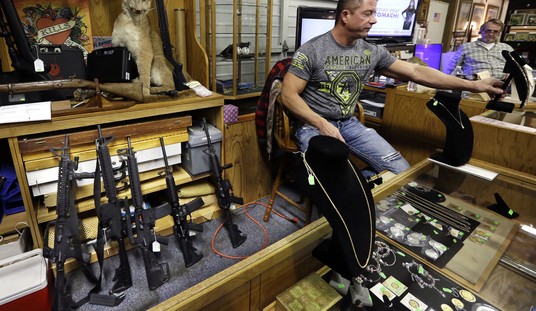Smith & Wesson is following Ruger out of the California semi-automatic pistol market in what is almost certain to be a mass exodus if the law stands:
Smith & Wesson announced late Wednesday evening that it will stop selling its handguns in California rather than manufacture them to comply with the new microstamping law. The other publicly traded firearms manufacturer in the U.S., Sturm, Ruger, also said this month that it will stop new sales to California.
The announcement came a week after the National Shooting Sports Foundation (NSSF), the trade association for firearms manufacturers, filed suit against California for requiring that all new semi-automatic pistols that are not already on the state’s approved gun roster have the microstamping technology.
Microstamping doesn’t work, on any level.
The theory is that a laser can etch the firing pin and breech face of a semi-automatic firearm, so that when a round is fired, a uniquely identifying mark is left on the primer by the firing pin, and another is left upon the cartridge case by the breech face etching.
It’s all quite cute in theory, but falls apart in the real world for raft of reasons that even Wikipedia could figure out:
- Stamped casing can only be traced to the last registered owner, not to the person who used the gun when the casings were stamped. In the case of a stolen gun, as is the case for most firearms used in crime, the stamped case would not lead to the criminal.
- Unscrupulous individuals could collect discarded brass from a firing range and salt crime scenes with microstamped cases, thereby providing false evidence against innocent people and increasing the workload for investigators.[5]
- High costs for testing the efficacy of the technique must be passed on to customers, increasing the cost of firearms for those who obtain them legally.[5]
- Microstamping is easily defeated. Diamond coated files are inexpensive and will remove microstamping. Firing pins are normally replaceable and can be changed with simple tools or without tools. Firing a large number of rounds will wear down the microstamp.[5] Marked components such as slides, barrels, firing pins and ejectors are all easily and commonly replaced items.[6]
- Microstamping is an immature, sole source technology, and has not been subjected to sufficient independent testing. Transfer of microstamped marks to the cases is less reliable than proponents claim.[5]
- Microstamping would be irrelevant/non-applicable for implementation of revolvers as these types of weapons do not eject shell cases necessarily.
- Ejected casings can be easily collected and removed from a crime scene.
Specific to California, opponents say:
- Firearms sold to law-enforcement are exempt. Problems could arise if a police officer’s firearm is used in a crime or stolen, and the fact that a firearm is “unsafe” if not provided with stamping technology exposes the police to liability.[7]
- Guns manufactured before an effective date are exempt and the bill does not extend to guns outside of California. There’s no possibility that this bill would ever cover enough guns to provide the investigative advantage claimed for it by the proponents.[5]
- Failures of the microstamping parts of a firearm makes it “unsafe” under the California law, which then becomes illegal to sell, give or lend under existing law.[8]
Much like the “smart guns” New Jersey is trying to wish into reality, the technology is highly suspect, failure prone, and the police themselves refuse to use it, a fact we discussed on Cam & Company yesterday.
The National Shooting Sports Foundation (NSSF)—which I feel compelled to note is the actual manufacturer’s lobby, not the NRA, despite the claims of serially-ignorant and hyperbole-prone gun grabbers— and the Sporting Arms and Ammunition Manufacturers’ Institute (SAAMI) are challenging the micro-stamping law in court:
“There is no existing microstamping technology that will reliably, consistently and legibly imprint the required identifying information by a semiautomatic handgun on the ammunition it fires. The holder of the patent for this technology himself has written that there are problems with it and that further study is warranted before it is mandated. A National Academy of Science review, forensic firearms examiners and a University of California at Davis study reached the same conclusion and the technical experts in the firearms industry agree,” said Lawrence G. Keane, NSSF senior vice president and general counsel. “Manufacturers can not comply with a law the provisions of which are invalid, that cannot be enforced and that will not contribute to improving public safety. As a result, we are seeking both declaratory and injunctive relief against this back-door attempt to prevent the sale of new semiautomatic handguns to law-abiding citizens in California.”
We can hope that this failed dream technology is defeated in the courts and that California’s deranged legislators doesn’t come up with something even more far-fetched and inoperable.
[microstamping image via The CalGuns Foundation]








Join the conversation as a VIP Member